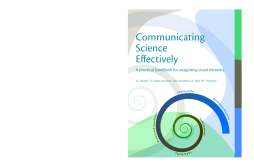
BOOK
Communicating Science Effectively
J. Thomas | A. Jones | T. Saxby | T. Carruthers | E. Abal | W. Dennison
(2006)
Additional Information
Book Details
Abstract
This is a practical handbook on how to communicate science effectively. The first part is an introduction to the principles of science communication and what effective science communication is, why it is important, and how to do it. The principles in these chapters include how effective science communication can change societal paradigms and make one a better scientist. General principles relating to all science communication products include providing synthesis, visualisation, and context, assembling self-contained visual elements such as photos, maps, conceptual diagrams and data, formatting content to define and simplify terms, and eliminating jargon and acronyms. Formatting of these visual elements is also discussed. This introduction is followed by chapters outlining techniques and principles for communicating in different media & desktop publishing (including posters and newsletters), presentations and websites. Techniques in these chapters include image, colour, and font formats, resolution and design tips for different media. Finally, a case study is presented to illustrate how effective science communication has become an integral part of a successful environmental science, monitoring, planning, and implementation program. The book is accompanied by extensive internet resources, including interactive software tutorials for the different software programs commonly used in communication, discussion forums for science communication issues, and links to other websites of interest. This book will be a valuable resource for scientists, working in government, research, management agencies, and education. Although environmental scientists are the primary audience, the principles and techniques discussed are applicable to scientists from all fields.
Table of Contents
| Section Title | Page | Action | Price |
|---|---|---|---|
| Table of contents | iv | ||
| Preface | vi | ||
| 1. Why is effective science communication important? | 1 | ||
| Effective science communication changes societal paradigms | 2 | ||
| Effective science communication can make you a better scientist | 4 | ||
| The essence of science communication | 4 | ||
| Further information | 5 | ||
| 2. What is effective science communication? | 7 | ||
| Providing synthesis, visualization, and context | 7 | ||
| Simplifying your terms but not your content | 8 | ||
| Assembling self-contained visual elements | 9 | ||
| Eliminating jargon, defining your terms, and minimizing acronym usage | 14 | ||
| Engaging your audience—prepare for and invite questions | 14 | ||
| References | 14 | ||
| 3. How do we communicate science effectively? | 15 | ||
| Make content the first priority | 15 | ||
| Develop a consistent style and format | 15 | ||
| Format your text effectively | 16 | ||
| Use color, but use it judiciously | 21 | ||
| Use the right resolution for your graphics | 24 | ||
| Use the right image types and formats | 26 | ||
| Format your visual elements effectively | 29 | ||
| References | 45 | ||
| Further information | 45 | ||
| 4. Conceptual diagrams | 47 | ||
| Conceptual diagrams are 'thought drawings' | 47 | ||
| Symbols form a visual language | 50 | ||
| Why use conceptual diagrams? | 51 | ||
| Create your own conceptual diagrams | 56 | ||
| References | 57 | ||
| Further information | 57 | ||
| 5. Desktop publishing | 59 | ||
| What is graphic design? | 60 | ||
| Steps in the graphic design process | 60 | ||
| There are six principles of design | 61 | ||
| Other desktop publishing and design tips | 73 | ||
| Further information | 78 | ||
| 6. Posters and newsletters | 79 | ||
| Posters | 79 | ||
| Newsletters | 86 | ||
| References | 88 | ||
| Further information | 88 | ||
| 7. Presentations | 89 | ||
| Communicating your message effectively | 89 | ||
| Components of a good scientific presentation | 91 | ||
| Formatting your slides effectively | 94 | ||
| Further information | 97 | ||
| 8. Websites | 99 | ||
| What is the web? | 99 | ||
| Why have a website? | 100 | ||
| What should you have on your website? | 100 | ||
| Layout and design | 100 | ||
| Website organization | 104 | ||
| Website formatting | 106 | ||
| Website coding | 111 | ||
| Making your site live | 115 | ||
| Tips and tricks | 116 | ||
| 9. A case study of effective science communication | 119 | ||
| What is the Healthy Waterways Partnership? | 119 | ||
| Communicating science: an adaptive process | 121 | ||
| How effective science communication can result in good management decisions | 124 | ||
| Conclusions | 129 | ||
| References | 129 | ||
| Further information | 129 | ||
| 10. Index | 131 |
